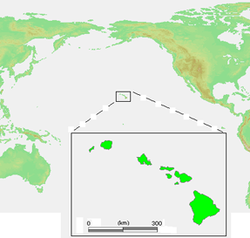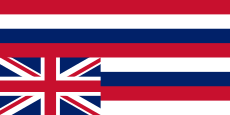
Back جمهورية هاواي Arabic Havajská republika Czech República de Hawái Spanish Havaijin tasavalta Finnish République d'Hawaï French Lepupalika o Hawaiʻi HAW הרפובליקה של הוואי HE Republik Hawaii ID Repubblica delle Hawaii Italian ハワイ共和国 Japanese
Republic of Hawaii Lepupalika o Hawaiʻi | |||||||||
|---|---|---|---|---|---|---|---|---|---|
| 1894–1898 | |||||||||
Motto:
| |||||||||
| Anthem: "Hawaiʻi Ponoʻī" "Hawaiʼi's Own True Sons" | |||||||||
 | |||||||||
| Capital | Honolulu | ||||||||
| Common languages | English, Hawaiian | ||||||||
| Government | Unitary presidential republic under a one-party regime | ||||||||
• President | Sanford B. Dole | ||||||||
• Vice President | William Chauncey Wilder | ||||||||
| History | |||||||||
• Established | July 4, 1894 | ||||||||
| January 6, 1895 | |||||||||
• Restoration attempt ends | January 9, 1895 | ||||||||
| August 12, 1898 | |||||||||
| Currency | Hawaiian dollar, U.S. dollar | ||||||||
| |||||||||
| Today part of | United States | ||||||||
| Part of a series on the |
| Hawaiian sovereignty movement |
|---|
 |
| Main issues |
| Governments |
| Historical conflicts |
| Modern events |
| Parties and organizations |
| Documents and ideas |
| Books |
| Part of a series on the |
| History of Hawaii |
|---|
| Topics |
The Republic of Hawaii (Hawaiian: Lepupalika o Hawaiʻi) was a short-lived one-party state in Hawaiʻi between July 4, 1894, when the Provisional Government of Hawaii had ended, and August 12, 1898, when it became annexed by the United States as an unincorporated and unorganized territory. In 1893, the Committee of Public Safety overthrew Queen Liliʻuokalani, the monarch of the Kingdom of Hawaiʻi, after she rejected the 1887 Bayonet Constitution. The Committee of Public Safety intended for Hawaii to be annexed by the United States; however, President Grover Cleveland, a Democrat opposed to imperialism, refused. A new constitution was subsequently written while Hawaii was being prepared for annexation.
The leaders of the Republic, such as Sanford B. Dole and Lorrin A. Thurston, were Hawaii-born descendants of American settlers who spoke the Hawaiian language but had strong financial, political, and family ties to the United States. They intended the Republic to become a territory of the United States. Dole was a former member of the Royal Legislature from Koloa, Kauai, and Justice of the Kingdom's Supreme Court, and he appointed Thurston—who had served as Minister of the Interior under King Kalākaua—to lead a lobbying effort in Washington, D.C., to secure Hawaii's annexation by the United States. The issue of overseas imperialism was controversial in the United States due to its colonial origins. Hawaii was annexed under Republican President William McKinley on 12 August 1898, during the Spanish–American War. The Territory of Hawaii was formally established as part of the U.S. on June 14, 1900.
The Blount Report "first provided evidence that officially identified the United States' complicity in the lawless overthrow of the lawful, peaceful government of Hawaii."[2] American officials immediately recognized the new government and troops from the U.S. Marine Corps (USMC) were sent by the U.S. Minister to aid in the overthrow. The Queen's supporters claimed that the Marines presence frightened the Queen and thus enabled the revolution.[3] Blount concluded that the United States had carried out unauthorized partisan activities, including the landing of U.S. Marines under a false or exaggerated pretext, to support the anti-royalist conspirators; that these actions were instrumental to the success of the revolution; and that the revolution was carried out against the wishes of a majority of the population of Hawaii.[4]
- ^ Spencer, Thomas P. (1895). Kaua Kuloko 1895. Honolulu: Papapai Mahu Press Publishing Company. OCLC 19662315.
- ^ Ball, Milner S. "Symposium: Native American Law," Georgia Law Review 28 (1979): 303
- ^ Ralph S. Kuykendall (1967). The Hawaiian Kingdom: 1874–1893, the Kalakaua dynasty. U of Hawaii Press. pp. 601–4. ISBN 9780870224331.
- ^ Tate, Merze. (1965). The United States and the Hawaiian Kingdom: A Political History. New Haven and London: Yale University Press. p. 235.
© MMXXIII Rich X Search. We shall prevail. All rights reserved. Rich X Search

